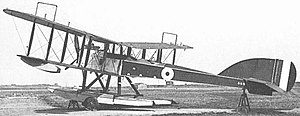|
Wight Converted Seaplane
The Wight Converted Seaplane was a British twin-float patrol seaplane produced by John Samuel White & Company Limited (Wight Aircraft). Design and developmentDeveloped from the unsuccessful Wight Bomber for use as an anti-submarine patrol aircraft, the "Converted" Seaplane was a straightforward adaptation of the landplane bomber to a seaplane. The aircraft was a three-bay biplane with unswept, unequal span, unstaggered wings. It had twin floats under the fuselage and additional floats at tail and wings tips. Initial production aircraft were powered by a 322 hp Rolls-Royce Eagle IV engine mounted in the nose driving a four-bladed propeller, with later production batches being powered by a 265 hp (198 kW) Sunbeam Maori engine owing to shortages of Eagles.[1] Fifty were ordered for the RNAS, of which only 37 were completed.[2] Operational historyThe Converted Seaplane entered service with the RNAS in 1917,[1] operating from bases at Calshot, Dover, Portland and Cherbourg.[2] On 18 August 1917, a Wight Converted Seaplane flying from Cherbourg sank the German U-boat UB-32 with a single 100 lb bomb, the first submarine to be sunk in the English Channel by direct air action.[1] Seven remained in service with the RAF at the end of the First World War. OperatorsSpecifications (Seaplane – Eagle engine)Data from The British Bomber since 1914 [1] General characteristics
Performance
See alsoAircraft of comparable role, configuration, and era Related lists References
External linksWikimedia Commons has media related to Wight Converted Seaplane.
|
||||||||||||||||||
